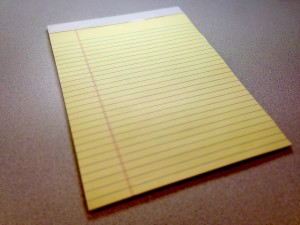“I am the biggest ever skeptic. But I thought what the heck. My lower back pain has been very bad and persistent whenever I stand or walk for more than a minute. I read the forward and immediately began using the ‘expressive writing.’ You take paper and pen/pencil and write, scribble whatever evil, painful, happy, violent, bad, mean things are in your head. When you finish a page, rip it up totally. Optimally should be twice a day 15-30 minutes each time. I started at 10 minutes twice a day. Every time I finished a sheet of paper, I ripped it up. Beyond my belief, the very next day, my back pain was GONE. Now I know I have a long way to go to be ‘cured’ but this is such a miracle for me, I am so very grateful.
“Now I will read the whole book. Recommend 100%”
–An Amazon reader
Breaking my fall
The above quote is an Amazon review of the second edition of my book, Back in Control. Feedback like this from readers bolsters my belief in the expressive writing exercise and how critical it is to the DOC (Direct your Own Care) process.

I completely understand what the reader went through: After over fifteen years of trying everything I could get my hands on to relieve my pain—“desperate” does not begin to describe my frantic search for a solution—I had lost all hope. Then, in 2002, I inadvertently discovered expressive writing and put it to the test. Within two weeks I noticed a shift in my mood, and within six months I had pulled myself out of the deadly tailspin of chronic pain.
But the expressive writing exercise seems so simple, I fear that, when I recommend it to patients, many of them feel that I don’t believe they are really in pain nor do I understand the depth of their suffering. Yet, in addition to my experience and that of many other chronic pain sufferers, over 300 research papers document its effectiveness; while essentially no papers validate the benefit of a spine fusion for low back pain. Compared to spine surgery, how much risk is there in writing down your thoughts and then discarding the pages? What can you lose by trying it out?
I have consistently observed that expressive writing is the first step toward healing, and little of substance happens until a patient engages the process. When I walk into an exam room, I can tell within thirty seconds if my patient has started to write. If not, I offer more details of its importance. I tell my patients that reading my book is helpful, but it will not make a difference in their mood or in their level of pain. I ask them to return a few weeks after they begin writing.
“This is ridiculous!”
One patient, a professor, came to me with lower back nerves that were so tightly pinched, they were causing leg pain. He refused to do the writing. I told him I thought he would benefit from a simple operation, called a laminotomy, to relieve the pressure. However, I said he would need to find another surgeon, since he was not willing to employ even the simplest tools to contribute to his recovery. A few weeks later, he returned. Laughing, he said, “This is ridiculous! I began the writing and within a week my pain was gone!” He began to employ the rest of the DOC strategies. Three years later, he is still pain free. He may need surgery someday; but now, it would make no sense. Why perform surgery on someone who is feeling fine?
Mental pain = physical pain
I have a theory to explain why expressive writing works so well to alleviate chronic pain, and it comes from my review of the latest neuroscience research, for the second edition of my book. The studies find that the nervous system processes thoughts the same way that it responds to physical sensations such as taste, smell, and pain. All these stimuli—whether they are thoughts, feelings, or physical sensations—are interpreted as sensory input, they travel the same neural pathways, and the body responds with essentially the same chemical reactions. So, from a purely neurological standpoint, emotional pain and physical pain are equivalent stimuli. In fact, I’m now convinced that anxiety is actually the pain. If that sounds crazy, consider this: Most of my patients, when I ask them if they would rather relieve their physical pain or the mental anguish that goes along with it, say they wish to be free of the anxiety. That is the intolerable part. That certainly was my experience. Am I operating on your pain or anxiety?
Compared to other living creatures, we humans have the unique problem of harboring unpleasant thoughts that are difficult or even impossible to escape from. Each person struggles with anxiety over the course of his or her lifetime, either addressing it or masking it, with varying decrees of success. All the writing does is free you from these repetitive circuits, so that you can redirect your attention and focus on other things. That’s it. It is neither a solution nor a “fixing” exercise. It’s more of a “disassociation” exercise.
The neuroscience research has shown that chronic pain is driven by the emotional regions of the brain. Since writing taps into and releases strong emotions such as anger, blame and anxiety there is “space” for other more positive connections. (1)
Just start the expressive writing
So I ask my patients to begin their expressive writing even before they read my book or dive into my website, and to destroy their written pages immediately after they finish them. There are two good reasons for not saving your pages: First, knowing that no one else will see them, you can write with complete freedom. You do not want to censor any thoughts or feelings, no matter how harsh or otherwise unacceptable they may seem to you. (Research shows that suppressing thoughts can damage the memory center of your brain.) (2) Second, as I mentioned in the last section, the writing is meant only to create distance from your thoughts. For our purposes, analyzing your thoughts and feelings is counter-productive. It focuses your attention on those negative thoughts, which further reinforces the pain-inducing neural pathways. Trying to “fix” yourself is like placing your hand into a hornet’s nest. A pain colleague has succinctly pointed out that holding on to your written words from the expressive writing exercise means you are holding on to your pain.
Certainly many other forms of creative writing are meant to be saved and refined. But expressive writing is only an exercise, to be performed once or twice a day, and its output is to be discarded. If you can’t write, you could record your thoughts audibly, although saying them out loud engages a different set of brain circuits. David Burns, in his book Feeling Good, suggests standing in front of a mirror and verbalizing the self-critical thoughts in your head. Notice how hard on yourself you are. Would you ever talk to another human being that way?
Make it a routine
Consider expressive writing as something you do automatically every day, like brushing your teeth. You’ll find that it’s such a powerful tool that it is habit forming. I’ve made it part of my daily routine, although I confess that sometimes I neglect it. During these periods, within a couple of weeks, symptoms of neurophysiologic disorder (NPD) predictably return. My sleep quality drops, I am more reactive, my scalp itches, my feet burn, and rashes reappear on my wrists. My wife will ask me, “Honey, have you been doing your writing?”
Resistance to Expressive Writing
It is remarkable how resistant so many people are to this simple but profound exercise. There is no cost or risk. It can be done anywhere and it only takes a few minutes. How much time do you spend on your smartphone? Why on earth wouldn’t you do this? I have so many more thoughts on this subject, which I will discuss at a later date; but for now, I have only one question for you: How much do you really want to give up your pain?

- Hashmi J, et al. Shape shifting pain: chronification of back pain shifts brain representation from nociceptive to emotional circuits. Brain (2013); 136; 2751–2768.
- Hulbert J, et al. Inducing amnesia thought systemic suppression. Nature Communications (2016); 7:11003.
